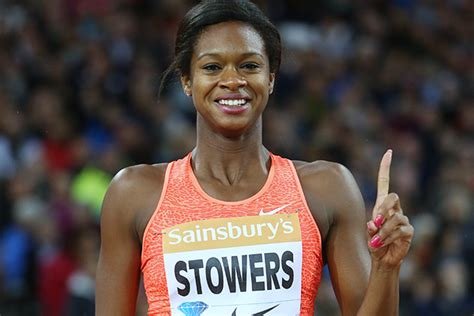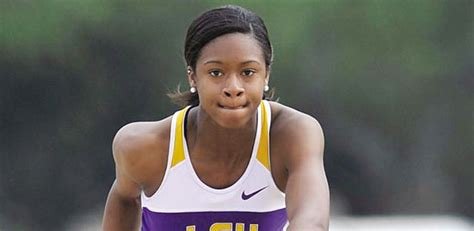 Jasmin Stowers, photo 1 by World Athletics
Jasmin Stowers, photo 1 by World Athletics
 Jasmin Stowers, photo 2 by World Athletics
Jasmin Stowers, photo 2 by World Athletics
Jasmin Stowers has ended her career due to injuries. Stuart Weir did this piece to put her career in perspective…
Jasmin Stowers
Earlier this month, Jasmin Stowers ended her career as an elite sprint hurdler at the age of 29. Costas Goulas tweeted “she showed so much potential between 2015 and 2017 especially”.
“Potential” is probably an appropriate word. She had a PR of 12.35 outdoors and won the US national indoor title in 2015. Yet she never made a global championship.
Jasmin Stowers (@missjazzy44) announced her decision to retire at 29 after setbacks with a back injury that caused pain in her leg.
Her 100m hurdles personal best of 12.35 seconds puts her as the sixth-fastest of all-time for @usatf and No. 11 in the world ever in the event. pic.twitter.com/ckkc2zgWs5
— Chris Chavez (@ChrisChavez) October 23, 2020
When she won the Doha 2015 Diamond League race in 12.35, not too many people outside of USA knew much about her. When she added Diamond League victories in Oslo and London, everyone had to sit up and take notice. However, in addition to three Diamond Leagues wins, she also false started in Birmingham and hit a hurdle in Rome that year.
She admitted, in a conversation with me that year, that had not seen her time in Doha of 12.35 had been a surprise: “I didn’t see it coming but I had run 12.39 in Jamaica so I knew that running in the 12.30s was possible. I was nervous because I was racing against Sally Pearson and Dawn Harper so I knew I had to run fast to beat them. The only thing on my mind was run – and I ended up running that time”.
The US championships and World Championship trials always seem to the non-American to be as brutal as it gets. Reputations count for nothing; first three are selected – no ifs no buts. Stowers ran 12.47 and 12.54 to reach the final where her 12.65 only gave her fifth place. Her time in the prelim or semi would have won the World Championship final in Beijing in 2015 and her time for fifth in the US Champs would have got bronze in Beijing.
Stowers commented very graciously afterwards: “I wish there at a way that we could all run at the World Champs. Perhaps it could be based on the top times in the world but I guess it’s fair having just three girls from each country. But it’s crazy the way the race is so stacked and I just wish it was a little different” but added: “It really hit me when I was on the plane headed back home and I started crying. I had worked so hard and this was the meet that really counted and I wasn’t able to execute it the way I should have. It was definitely something I learnt from and will help me to prepare for the next US championship”.
I remember conversations with Dawn Harper-Nelson after her silver medal in London 2017 at the age of 33, about the importance of experience and the ability to run rounds.
Stowers’ assessment of 2015 was thoughtful and realistic: “It was definitely a surprising year because I did not expect to run that fast so early in my first year out of college. It was definitely a breakout year. I am glad I had that year and it enabled me to get into more meets and get my name up there – so it was definitely exciting. The hurdles are always unpredictable because one mistake can cost you the whole race. In Birmingham [false start] I wasn’t even able to run and I think that is the most disappointing because you’ve trained hard and warmed up properly and you’ve come to race. So I was really disappointed in Birmingham. Rome was a really complicated hurdles race because Sally Pearson fell, Brianna fell and I didn’t finish. That was really awkward because I had never really hit hurdles before that so not finishing that race was disappointing.
“Oslo was immediately after Birmingham where I false started so I was a bit nervous about it and held back in the blocks a little. I remember that Brianna was in the race and I had tried to beat her and I think we finished in the same time” [Stowers 1st, Brianna Rollins 2nd both in
12.84]”.
The way she reacted to the disappointment of the 2015 US Trials was to come to London for the Diamond League and run 12.47 into a -1.2 wind and win the race! She commented:”The London race came just after the trials and a couple of other meets I had done and I was just tired of losing. I tried to get it into my head that I was one of the best hurdlers in the world. So I just gave it all my energy and finished up breaking the London Diamond League record. And that was pretty cool to me. I actually I didn’t know it was a negative wind until someone told me afterwards and I was ‘whao I didn’t know that'”.
Her struggles to navigate the US Trials continued. In 2016, she mad ethe final but hit a hurdle and finished 8th. In 2017 she again reached the final and finished 8th in 12.94. In the semi, she had run 12.47; Sally Pearson would win the 2017 Worlds in 12.59. Stowers won two more Diamond League races – Brussels in 2016 and Eugene in 2017 (in 12.59).
Sprint hurdlers are often small. World record-holder, Keni Harrison, is 5 foot 4. Megan Tapper, a finalist in the 2019 Worlds, is 5 foot 1. Stowers, on the other hand, is 5 foot 9. I was asked her if she thought her height was an advantage or disadvantage: “A lot of people say that shorter hurdlers are better able to run through the hurdles, because they have the distance between the hurdles to sprint while for taller hurdlers, we have to chop it up more. But my body is in proportion and my upper half is way taller than my legs so I feel I’m able to bring a quicker rhythm to the hurdles. I also think that me being taller than, say Sally Pearson, makes it easier for me to go over the hurdles. Instead of putting effort into getting over the hurdle I can just step over it. I think that is something which separates taller hurdler from others that we are able to step over the hurdles and keep going”.
I enjoyed watching Jasmin Stowers and talking to her on a number of occasions. To have won a US championship and five Diamond Leagues places her in the absolute top bracket – as do her runs of 12.35, 12.47 etc. The failure to reach an Olympics or World Championships is the weakness in her career summary.
Author

Since 2015, Stuart Weir has written for RunBlogRun. He attends about 20 events a year including all most global championships and Diamond Leagues. He enjoys finding the quirky and obscure story.
View all posts


















